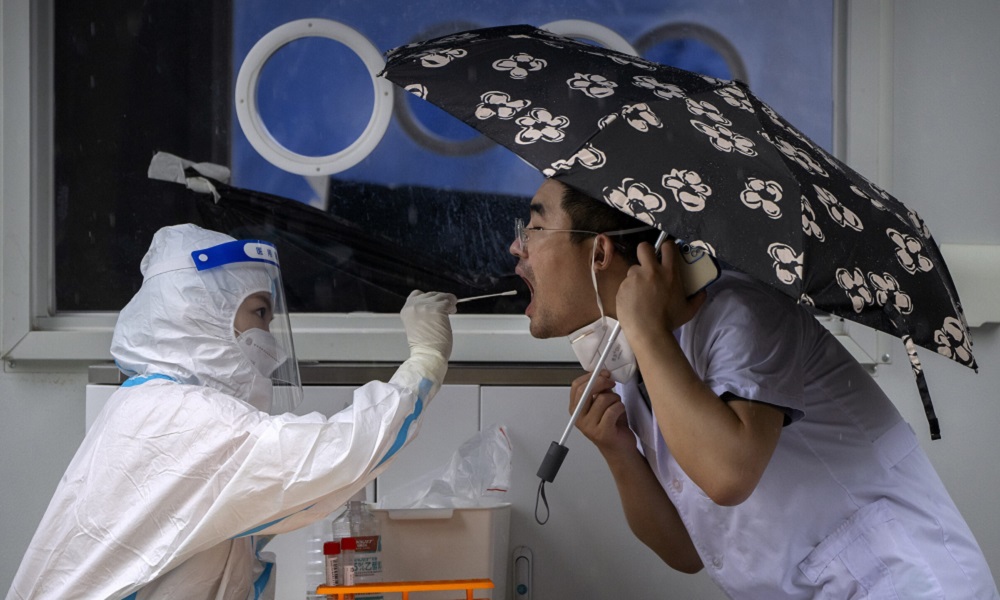COVID-19
WHO urges travellers to wear masks as new COVID variant spreads

Countries should consider recommending that passengers wear masks on long-haul flights, given the rapid spread of the latest Omicron subvariant of COVID-19 in the United States, World Health Organization (WHO) officials said on Tuesday.
In Europe, the XBB.1.5 subvariant was detected in small but growing numbers, WHO and Europe officials said at a press briefing, Reuters reported.
Passengers should be advised to wear masks in high-risk settings such as long-haul flights, said the WHO's senior emergency officer for Europe, Catherine Smallwood, adding: "this should be a recommendation issued to passengers arriving from anywhere where there is widespread COVID-19 transmission".
XBB.1.5 - the most transmissible Omicron subvariant detected so far - accounted for 27.6% of COVID-19 cases in the United States for the week ended Jan. 7, health officials have said.
It was unclear if XBB.1.5 would cause its own wave of global infections. Current vaccines continue to protect against severe symptoms, hospitalisation and death, experts say.
"Countries need to look at the evidence base for pre-departure testing" and if action is considered, "travel measures should be implemented in a non-discriminatory manner," Smallwood said.
That did not mean the agency recommended testing for passengers from the United States at this stage, she added.
Measures that could be taken include genomic surveillance, and targeting passengers from other countries as long as it does not divert resources from domestic surveillance systems. Others include monitoring wastewater around points of entry such as airports, read the report.
XBB.1.5 is another descendant of Omicron, the most contagious and now globally dominant variant of the virus that causes COVID-19. It is an offshoot of XBB, first detected in October, itself a recombinant of two other Omicron subvariants.
According to Reuters concerns about XBB.1.5 fuelling a fresh spate of cases in the United States and beyond are on rising amid a surge of COVID cases in China, after the country pivoted away from its signature "zero COVID" policy last month.
According to data reported by the WHO earlier this month, an analysis by the Chinese Center for Disease Control and Prevention showed a predominance of Omicron sublineages BA.5.2 and BF.7 among locally acquired infections.
The European Union Aviation Safety Agency (EASA) and the European Centre for Disease Prevention and Control (ECDC) on Tuesday issued recommendations for flights between China and the European Union including "non-pharmaceutical measures to reduce the spread of the virus, such as mask-wearing and testing of travellers, as well as monitoring of waste water as an early warning tool to detect new variants."
The agencies recommend "random testing may also be carried out on a sample of arriving passengers" and "enhanced cleaning and disinfection of aircraft serving these routes."
Last week, the EU's Integrated Political Crisis Response group (IPCR), is a body made up of officials from the EU's 27 governments, also recommended all passengers on flights to and from China should wear face masks and random testing of passengers arriving from China, Reuters reported.
Many scientists - including from the WHO - believe China is likely under-reporting the true extent of its outbreak.
The WHO is aware that the case-definition of what counts as a COVID-19 death in China is narrow and "not necessarily the case definition that WHO has recommended countries adopt," said Smallwood.
More than a dozen countries - including the United States - are demanding COVID tests from travellers from China.
COVID-19
WHO declares end to COVID global health emergency

The World Health Organization said Friday that COVID-19 no longer qualifies as a global emergency, marking a symbolic end to the devastating coronavirus pandemic that triggered once-unthinkable lockdowns, upended economies and killed millions of people worldwide.
The announcement, made more than three years after WHO declared the coronavirus an international crisis, offers some relief, if not an ending, to a pandemic that stirred fear and suspicion, hand-wringing and finger-pointing across the globe, AP reported.
The U.N. health agency’s officials said that even though the emergency phase was over, the pandemic hasn’t finished, noting recent spikes in cases in Southeast Asia and the Middle East.
WHO says thousands of people are still dying from the virus every week, and millions of others are suffering from debilitating, long-term effects.
“It’s with great hope that I declare COVID-19 over as a global health emergency,” WHO Director-General Tedros Adhanom Ghebreyesus said.
“That does not mean COVID-19 is over as a global health threat,” he said, warning that new variants could yet emerge. Tedros noted that while the official COVID-19 death toll was 7 million, the real figure was estimated to be at least 20 million.
Tedros said the pandemic had been on a downward trend for more than a year, acknowledging that most countries have already returned to life before COVID-19.
He bemoaned the damage that COVID-19 had done to the global community, saying the pandemic had shattered businesses, exacerbated political divisions, led to the spread of misinformation and plunged millions into poverty.
When the U.N. health agency first declared the coronavirus to be an international crisis on Jan. 30, 2020, it hadn’t yet been named COVID-19 and there were no major outbreaks beyond China.
More than three years later, the virus has caused an estimated 764 million cases globally and about 5 billion people have received at least one dose of vaccine.
In the U.S., the public health emergency declaration made regarding COVID-19 is set to expire on May 11, when wide-ranging measures to support the pandemic response, including vaccine mandates, will end. Many other countries, including Germany, France and Britain, dropped most of their provisions against the pandemic last year.
When Tedros declared COVID-19 to be an emergency in 2020, he said his greatest fear was the virus’ potential to spread in countries with weak health systems.
Most recently, WHO has struggled to investigate the origins of the coronavirus, a challenging scientific endeavor that has also become politically fraught.
COVID-19
COVID-19 in Iran: Nearly 900 new cases, 24 deaths recorded

The Iranian health ministry announced on Sunday that more than 890 new cases of COVID-19 have been identified across the country during the past 24 hours, adding that 24 patients have died in the same period of time, Fars News Agency reported.
"A sum of 891 new patients infected with COVID-19 have been identified in the country based on confirmed diagnosis criteria during the past 24 hours," the Iranian Health Ministry's Public Relations Center said on Sunday, adding, "454 patients have been hospitalized during the same time span."
The ministry’s public relations center said 611 people infected with COVID-19 are in critical condition.
COVID-19
China says 200 million treated, pandemic ‘decisively’ beaten

China says more than 200 million of its citizens have been diagnosed and treated for COVID-19 since it lifted strict containment measures beginning in November.
With 800,000 of the most critically ill patients having recovered, China has “decisively beaten” the pandemic, according to notes from a meeting of the ruling Communist Party’s all-powerful Politburo Standing Committee presided over by President and party leader Xi Jinping, AP reported.
China enforced some of the world’s most draconian lockdowns, quarantines and travel restrictions and still faces questions about the origins of the virus that was first detected in the central Chinese city of Wuhan in late 2019. Heavy-handed enforcement prompted rare anti-government protests and took a heavy toll on the world’s second-largest economy.
The official Xinhua News Agency quoted Xi as saying that policies to control the outbreak had been “entirely correct.” The abrupt lifting in November and December of the “zero COVID” policy that had sought to eliminate all cases of the virus led to a surge in infections that temporarily overwhelmed hospitals.
Case numbers have since peaked and life has largely returned to normal, although international travel in and out of China has yet to return to pre-pandemic levels.
China is now transitioning to a post-pandemic stage after a fight against the outbreak that was “extraordinary in the extreme,” Xinhua said.
The government will continue to “optimize and adjust prevention and control policies and measures according to the times and situations with a strong historical responsibility and strong strategic determination,” Xinhua said.
-

 Sport5 days ago
Sport5 days agoLanka T10: All three matches abandoned due to rain
-

 Latest News5 days ago
Latest News5 days agoIndia hoping to import coal and marble from Afghanistan
-

 Sport4 days ago
Sport4 days agoZimbabwe’s opening ODI against Afghanistan abandoned
-

 Latest News5 days ago
Latest News5 days agoJapan announces $27.5 million aid package to Afghanistan
-

 Latest News1 day ago
Latest News1 day agoAfghan men must stand with women to support viable future of country: US envoy
-

 Latest News3 days ago
Latest News3 days agoTwo horror accidents on Kabul-Kandahar highway leave 52 dead
-

 World3 days ago
World3 days agoNorth Korean troops suffer 100 deaths, struggling in drone warfare, South Korea says
-

 International Sports4 days ago
International Sports4 days agoLanka T10: Kandy Bolts in at 4th spot in playoffs after thrilling day
























